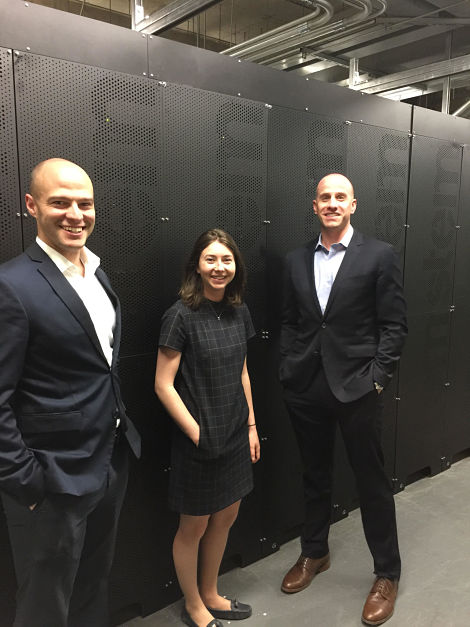
Black Bear Energy (BBE) is a firm led by two former Wal-Mart and Prologis executives who built and scaled the two largest onsite corporate solar programs in the US. It has a client base of 30 institutional property owners, all of whom have made their way to Black Bear by word of mouth, and over 3 billion square feet of real estate assets under management. The company recently announced three new solar, storage, and LED retrofit projects – commercial solar systems in Somerville and Cambridge, Massachusetts; a 2.4 MW solar rooftop array in Cranbury, New Jersey; and storage projects in California, Arizona, Colorado and Nevada.
REM talked to Black Bear Energy CEO Drew Torbin to find out more about the company, the projects it is currently involved in and where it hopes to go from here.
Can you tell me more about Black Bear Energy and what it does?
Black Bear is a buyer’s representative and client advocate, specifically to do with renewables and cleantech. Practically what that means is that we work with entities that own or use large commercial industrial properties, help them understand the opportunities they have to deploy new energy and then we assist them with that deployment. Through a competitive process, we match clients with the provider who best combines favourable economics, agreeable contractual terms and relevant experience. We’ll then help our clients negotiate contracts and oversee construction. In short, we’re a tech-enabled outsource energy team.
How are things in the US solar market at the moment?
Depends on which state. It’s all very different, but overall, it’s good. Very good. There are markets that are consistent – California and New Jersey I would state are two very consistent, especially with some new policies coming out of New Jersey, and then there are other markets that are newer, but are very strong – Massachusetts, Illinois, the big take on the US market is that it’s quite strong in a number of markets.
To what degree is energy storage now moving into the market to support other projects?
It’s only, really, at scale commercially in two states at the moment. I am not talking about grid scale, utility scale, but commercial buildings. California is the main state where this is happening, and that’s thanks to a rebate that’s offered throughout investor owned utilities in California. There’s lots of other markets where storage will soon be economic, and what we’re seeing, which is really interesting, is that lots of clients prefer to start with energy storage rather than solar. It’s physically a smaller project, the contract term is shorter, generally ten years or so, versus a twenty year for solar. It’s easy to see that when the economics do work, outside of California, how it will become ubiquitous.
A ‘disorganised market demand for onsite renewables’ has been mentioned. What does that refer to?
The market, the vendor communities, what we call the ‘sell side’ of renewables, is not terribly organised. So if you are a buyer, an owner, a potential buyer, well aware of the opportunities, you get all sorts of enquiries about it, but its difficult to implement, take action, because you may not have a large energy team like most of the big corporations. Without that market giving you a clear, organised, fact pattern, you don’t feel like you’re in a place where you can make informed decisions. That was the market failure that Kim and I saw three years ago that we launched Black Bear to address.
So how is Black Bear addressing that?
We address it by working on behalf of the buyer, educating them about what it would mean to deploy solar and storage and lighting, and there is a heavy amount of education that takes place. Secondly, we organise their data and put it out for competitive tender, instead of getting several different bids, our clients are getting back bids to standard specifications, that are coming from pre-qualified vendors, and are viewed by a group that is looking out for their best interests and has been doing it for over a decade.
Who are your main clients?
Our beachhead are institutional properties owners. Most of our clients own hundreds or thousands of buildings and all types, from industrial, office, multi-family residential, they own shopping malls, they own movie theatres, practically any commercial asset. There are many of those types of owners in the US and they are usually fairly streamlined in terms of their organisations, so they may have sustainability teams, some of them may have energy managers, but they don’t typically have a large enough team to allow them to spend time on renewable procurement.

Drew Torbin, Black Bear Energy CEO and his team at the LBA Realty campus in Irvine, CA
Can you tell me more about the main projects you are working on at the moment?
We average two plus RFPs per month. The three projects just announced are projects which have gone through procurement, been awarded and reached substantial milestones. The three projects, they are quite different but the similarities are that they are all on properties controlled by institutional owners who want to create additional value from these properties by deploying these technologies. So, in the case of USAA Real Estate Company, they are deploying solar on an industrial facility in New Jersey where they pay the utility bill and what we’ve helped them to achieve is to sign a power purchase agreement, which is a net neutral agreement, so they are not winning, not losing under that contract, and channel the benefit into rent. So, from their perspective as a property owner as a landlord, they have an additional rental income stream coming from that property over the next twenty years as well as a hedge on rising electricity rates. That’s a very typical structure for us. It’s a great project with a fantastic organization. One of their first solar projects I believe.
Separately with GID, a leading owner/developer of multi-family and commercial properties, there’s a series of projects in Massachusetts we are helping them with, and Massachusetts is one of the more lucrative markets in the US at the moment. Those projects will be on their site and similarly pay GID rent, so again they get an additional income stream from existing properties.
We also announced several milestones of progress with LBA Realty, an institutional owner of Class A office and Class A industrial. We’ve helped them with quite a few projects . They are a really forward leaning, forward thinking group, we’ve done energy storage with them, including one of the largest indoor energy storage projects in the world, at their campus in Irvine, we’ve done quite a few LED retrofits with them, so they’re very active, as are most of our clients. The most common question we get from clients is “Okay, that’s great, but what’s next? What else can we work on together?”
Do you have a presence just in the US or are you working abroad as well?
At the moment, we’re just in the US. Most of our clients have assets abroad and in our past lives, most of us have done work abroad, myself included, but for the moment we are US-focused.
Where do you see the company going in the near future, say over the next five to ten years or so?
We are in the midst in completing our Series B and that money will be used to fund two things, additional headcount so we can add more offerings, I mentioned that we are solar, energy storage, LED lighting, those are really the three technologies that we have for our clients, so we’ll be hiring some subject matter experts to add on additional products, but then separately we’ll be spending a lot of resources to further build out our online platforms. All of our RFPs are currently run through that platform today because all of our client data is there, but what we are going to build is something pretty innovative to give our clients a window into the activity in the market into possibilities on their site, to give them basically more data points they can use to help their core business and also help them understand what other opportunities they have with those technologies. There are a few other companies doing that but there’s nobody feeding it with true transaction data, like we have. The great thing about where we come in is that we sit directly next to the buyer and these every evolving opportunities. There’s no shortage of value creation opportunities at the intersection of real estate and energy, that’s for sure.
Prior to launching Black Bear, Kim and I ran the renewables group for Walmart and Prologis respectively. , We saw a market where each side desired to transact but where they were having significant trouble doing so. Black Bear was born out of an authentic experience in the market we now serve. Similarly, the technology we’re building is based off our authentic experience of running this business for three years and seeing the need to provide an overall better experience for both the buy and sell side. We view ourselves simply as instigators of positive change.
Images (Courtesy of Black Bear Energy):
Main image: BBE CEO Drew Torbin
In-text image: Drew and his team in front of one of the largest indoor energy storage projects in the world – the LBA Realty storage project at their campus in Irvine, California
For additional information:

